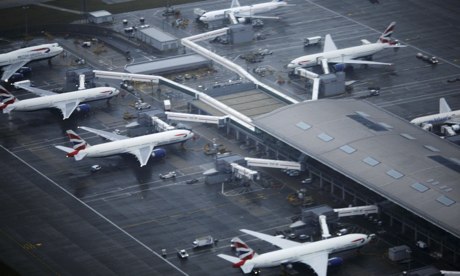Heathrow has said it will review its investment plans after the regulator made a surprise cut to the landing charges proposed at the airport, a move the airport describes as “draconian”.
The Civil Aviation Authority (CAA) decided to limit price rises below inflation for the next five years at Britain’s biggest airport, allowing an annual increase of RPI minus 1.5%, saying passengers should benefit.
The final decision comes three months after the CAA said it intended to raise the cap in line with inflation – a proposal Heathrow then described as the toughest it had faced.
Heathrow chief executive Colin Matthews said the CAA had taken a “draconian position”. He said: “We are concerned by the degree of change since the CAA’s final proposals just a short while ago.
“We want to continue to improve Heathrow for passengers. We will review our investment plan to see whether it is still financeable in light of the CAA’s settlement.”
Heathrow said the decision greatly stretched targets and left few resources spare to manage the consequences of potential disruption.
But Iain Osborne, director of regulatory policy at the CAA, said the settlement allowed for nearly £3bn of expenditure to increase resilience and improve facilities and the passenger experience. “We don’t accept that they can’t carry out their investments and make money. If they don’t build things passengers need, then we will put obligations in their licence we can enforce.”
Proposed charges were curbed due to lower borrowing costs and higher passenger forecasts, calculated through actual baseline figures for 2012-13 that outstripped predictions, as well as improved Treasury GDP forecasts. Current landing charges stand at £20.71 per passenger at Heathrow.
Airlines, which had sought deep cuts to charges, claimed to be disappointed by the ruling. A British Airways spokesman said it was “a step in the right direction” but added: “The fact remains that our customers will still be paying more than is warranted and there is plenty of scope for further efficiencies to be made.”
Virgin Atlantic’s chief executive, Craig Kreeger, said: “Today’s decision is a far cry from the reduction needed to mitigate the incredibly steep price rises customers have seen in Heathrow airport charges in the last few years.” He said the airline would be considering its right to appeal.
The CAA infuriated Ryanair by deciding that price regulation will no longer be required from April at Stansted airport, where the low-cost airline is by far the biggest customer. Ryanair said the regulator had “put the fox in charge of the chicken coop”. The airline’s director of regulatory affairs, Juliusz Komorek, said it regretted the “unsupported claim by the CAA that Stansted does not have substantial market power”.
But Osborne of the CAA said the recent deals struck with its major airline customers showed the weakness of the airport’s position. “The fact is that Ryanair and EasyJet together have over 90% of the traffic at the airport and have both signed 10-year deals. Price and volumes are locked in there for the next decade. We’ve concluded that Stansted doesn’t have market power.” Luton and Southend airport both provided alternative bases for low-cost carriers, he said.
Stansted’s owner, MAG, which bought the airport from Heathrow last February, welcomed the move. Chief executive Charlie Cornish said: “The CAA’s decision today to step back from regulating Stansted is a welcome endorsement of the changes we’ve made, and a positive recognition that in Stansted’s case competition rather than regulation will deliver the best outcomes for passengers and airlines.”
Meanwhile, Gatwick will continue to be regulated but without price caps , as the CAA accepted the airport’s commitment to reach individual agreements with airlines while restraining overall average charges. But Gatwick chief executive Stewart Wingate said he was disappointed that the airport was still to be regulated, and he hit out at the CAA for having lowered its benchmark for average charges, which it judged as a cut in real terms by 1.6% annually until 2019. Wingate said: “We are also disappointed at the CAA’s view of a fair price, as well as the intrusive nature of their monitoring requirements. The airport will need to review the detail of the CAA final decision and consider its position.”
Gatwick will be handed new statutory obligations to maintain resilience. The airport was the scene of chaos on Christmas Eve after flooding caused power failures.
EasyJet, which has accused Gatwick of lacking sufficient contingency plans, said it welcomed the news that “robust plans to deliver operational resilience in major disruption will also be under CAA regulatory oversight”.

